Test and review: Huawei P10 lite is a mid-range smartphone. Memory cards are used in mobile devices to increase the storage capacity for storing data. Screen. Graphics capabilities
Page 1: Test and review: Huawei P10 lite – mid-range smartphone
Like last year, Huawei has decided to introduce three smartphones in the P line. But while the P10 and P10 Plus were announced at MWC 2017 at the end of February, the P10 lite arrived four weeks later. Perhaps there was a reason for this: the lineup Huawei smartphones seems oversaturated. However, this did not affect the quality of the P10 lite.
Buying a lite smartphone in 2017 no longer seems so straightforward due to the large number of models. Indeed, over the past two years everything has been different. P8 lite was positioned below P8, and below P9. Now the consumer has to choose between three middle-class models with the lite suffix. , introduced at the end of January, remains the cheapest model, however, Huawei continues to promote the P9 lite, despite the appearance of the new P10 lite.

P10 lite promises to be an excellent mid-range smartphone
Basic specifications appear identical or very similar. The smartphone displays have the same diagonal and resolution; we also did not see any significant differences in performance. All three models are equipped with Android 7 or will receive the corresponding update in the coming weeks.
The question of price remains. P8 lite 2017 is sold at a price of 240 euros or 15.8 thousand rubles in Russia, for which you will also have to pay 240 euros or from 14 thousand rubles. P10 lite has not yet appeared in Russia; in Europe the price will be 349 euros, which is noticeably more expensive
Average performance as you'd expect from a Lite
The SoC clearly shows the similarities between the three smartphone models. For the P10 lite, Huawei chose its own Kirin 658, which contains two CPU clusters with four Cortex A53 cores each, as well as a Mali-T830 MP2 GPU. The chip is manufactured using the 16nm FinFET+ process. The GPU frequency is 900 MHz, CPU cores operate at maximum frequencies of 1.7 and 2.4 GHz. However, readers familiar with Huawei products will probably point out that the SoC belongs to the Kirin 650 line. The same was the case; the Kirin 655 processor, which was again used in the P8 lite 2017, is based on the same design and process technology. Except that the CPU clock speeds are a little lower.

P10 lite provides only slightly more performance than P9 lite or P8 lite (2017)
Therefore, you shouldn’t expect performance miracles from the P10 lite. In CPU-intensive scenarios, the increase compared to a smartphone is usually between 5 and 15%. If the focus shifts towards the GPU, then we do not get a noticeable difference. In the absolute performance rating, the P10 lite smartphone shows average results, in some places even below average. In the 3DMark test, the smartphone scored about 11,800 and 600 points (Ice Storm Unlimited/Slingshot), in AnTuTu 6 the overall performance was 61,300 points. The processor in Geekbench 4 showed 1,000 and 4,000 points in single- and multi-threaded tests, in GFXBench - 8 and 18 fps in the Manhattan Offscreen and T-Rex Offscreen tests. So the P10 lite can only be used conditionally as a mobile gaming console. Simple games will run smoothly, but in the case of “heavy” graphics, performance decreases, this also applies to the standard pre-installed Asphalt Nitro.

Behind the glass back of the Huawei P10 lies mid-level hardware
When compared with direct competitors, including Samsung Galaxy A3 (2017), then P10 lite performs quite well. In everyday scenarios, the smartphone showed no weaknesses, also thanks to its decent volume random access memory 4 GB for this price range. On the other hand, there is nothing noteworthy about the internal flash memory. In the Androbench test, we got a maximum of 137 and 101 MB/s for reading and writing.
Lots of memory, best fingerprint sensor
In the price segment above 300 euros, a memory capacity of 32 GB is taken for granted. It is also possible to expand the memory using microSD cards with a maximum capacity of 256 GB. But, as is often the case with Huawei, the memory card is installed instead of a second SIM card. Therefore, with support Dual SIM we'll have to separate. As usual, only one of the two SIM cards can be used for registration in 3G and 4G networks, the second SIM card will be used only for GSM.

Porta USB Type The P10 lite doesn't have C, but Huawei doesn't consider it important for the target audience
The smartphone modem supports Cat 6, that is, it can work in LTE networks with download speeds up to 300 Mbit/s and upload speeds up to 50 Mbit/s. In our tests, we did not encounter any problematic modem behavior or frequent network switching. Concerning voice communication, then two microphones provide good filtering of extraneous noise, and there are no complaints about the quality of voice capture either. The second speaker is located at the bottom end of the smartphone, it provides high level volume without distortion, but oh low frequencies It's better to forget.
In addition to the LTE modem, one can note support for WLAN 802.11ac, Bluetooth 4.1 and NFC for wireless transmission data. Wired transfer and charging of the smartphone is done via a micro-USB cable. As with the P8 lite 2017, Huawei decided to abandon the more modern and convenient Type C port. The reason is that Micro-USB cables are ubiquitous, and the thickness of the case is quite sufficient for such a connector. There is also a 3.5 mm audio jack.

For P10 lite, Huawei decided to choose the time-tested location of the fingerprint sensor
In addition to standard sensors (accelerometer, gyroscope and ambient lighting), the P10 lite adds a fingerprint scanner. In contrast, it is not placed under the display, but is located on the rear panel. Huawei has found an explanation for this: the P10 lite is aimed at selfie lovers who can use the sensor to release the camera shutter. The fingerprint recognition speed in our tests was quite high, and the sensor can also be used for additional control functions, unlike the P10. Thus, using the sensor, you can navigate in the gallery, answer calls or display the notification shade.
With P10 lite we get the best display
If you decide to make a choice between lite smartphones based on display characteristics, then you are unlikely to succeed. Both the P10 lite and the previous two models use a 5.2" IPS panel with a resolution of 1,920 x 1,080 pixels. What for modern smartphone not so happy anymore. And Huawei has also “lost weight” to 5.1" instead of 5.2".

The display of Huawei P10 lite can be considered an advantage
Otherwise, the P10 lite's display performs well. Thanks to IPS technology, viewing angles are quite wide, colors are saturated, but color reproduction remains quite accurate. Is it possible to complain that the color temperature is too cold, which cannot be improved manual settings display options. We were never able to achieve a temperature below 6,800 K. But the brightness more than compensates for this shortcoming. We received a brightness level of up to 595 cd/m², which is quite enough to work with a smartphone even in bright lighting conditions. We also rate the contrast ratio of 1.653:1 positively.
Information about the make, model, and alternative names of the specific device, if available.
Design
Information about the dimensions and weight of the device, presented in different units of measurement. Materials used, colors offered, certificates.
| Width Width information - refers to the horizontal side of the device in its standard orientation during use. | 72 mm (millimeters) 7.2 cm (centimeters) 0.24 ft (feet) 2.83 in (inches) |
| Height Height information - refers to the vertical side of the device in its standard orientation during use. | 146.5 mm (millimeters) 14.65 cm (centimeters) 0.48 ft (feet) 5.77 in (inches) |
| Thickness Information about the thickness of the device in different units measurements. | 7.2 mm (millimeters) 0.72 cm (centimeters) 0.02 ft (feet) 0.28 in (inches) |
| Weight Information about the weight of the device in different units of measurement. | 146 g (grams) 0.32 lbs 5.15 oz (ounces) |
| Volume The approximate volume of the device, calculated based on the dimensions provided by the manufacturer. Refers to devices with the shape of a rectangular parallelepiped. | 75.95 cm³ (cubic centimeters) 4.61 in³ (cubic inches) |
| Colors Information about the colors in which this device is offered for sale. | Golden White Black Blue |
| Materials for making the case Materials used to make the device body. | Metal |
SIM card
The SIM card is used in mobile devices to store data that certifies the authenticity of mobile service subscribers.
Mobile networks
A mobile network is a radio system that allows multiple mobile devices to communicate with each other.
| GSM GSM (Global System for Mobile Communications) is designed to replace the analogue mobile network (1G). For this reason, GSM is often called a 2G mobile network. It is improved by the addition of GPRS (General Packet Radio Services), and later EDGE (Enhanced Data rates for GSM Evolution) technologies. | GSM 850 MHz GSM 900 MHz GSM 1800 MHz GSM 1900 MHz |
| UMTS UMTS is an abbreviation for Universal Mobile Telecommunications System. It is based on the GSM standard and belongs to 3G mobile networks. Developed by 3GPP and its biggest advantage is providing greater speed and spectral efficiency thanks to W-CDMA technology. | UMTS 850 MHz UMTS 900 MHz UMTS 2100 MHz UMTS 800 MHz (WAS-LX2J) UMTS 850 MHz (B6) (WAS-LX2J) UMTS 1700/2100 MHz(WAS-L03T; WAS-LX3) UMTS 1900 MHz (WAS-LX1; WAS-LX1A; WAS-L03T; WAS-LX3) |
| LTE LTE (Long Term Evolution) is defined as a technology fourth generation(4G). It is developed by 3GPP based on GSM/EDGE and UMTS/HSPA to increase the capacity and speed of wireless mobile networks. The subsequent technology development is called LTE Advanced. | LTE 1800 MHz LTE 2100 MHz LTE 2600 MHz LTE 800 MHz (B18) (WAS-LX2J) LTE 850 MHz (WAS-LX2; WAS-LX2J; WAS-L03T; WAS-L3) LTE 900 MHz (WAS-LX1; WAS-LX1A; WAS-LX2; WAS-LX2J) LTE 1900 MHz (WAS-L03T; WAS-LX3) LTE 1700/2100 MHz (WAS-L03T; WAS-LX3) LTE 700 MHz (B12) (WAS-L03T) LTE 700 MHz Class 17 (WAS-L03T) LTE 800 MHz (WAS-LX1; WAS-LX1A) LTE 700 MHz (B28) (WAS-LX2; WAS-LX3) |
Mobile communication technologies and data transfer speeds
Communication between devices on mobile networks is carried out using technologies that provide different data transfer rates.
Operating system
An operating system is a system software that manages and coordinates the operation of hardware components in a device.
SoC (System on Chip)
A system on a chip (SoC) includes all the most important hardware components of a mobile device on one chip.
| SoC (System on Chip) A system on a chip (SoC) integrates various hardware components, such as a processor, graphics processor, memory, peripherals, interfaces, etc., as well as the software necessary for their operation. | Huawei HiSilicon KIRIN 658 |
| Technological process Information about the technological process by which the chip is manufactured. Nanometers measure half the distance between elements in the processor. | 16 nm (nanometers) |
| Processor (CPU) The primary function of a mobile device's processor (CPU) is to interpret and execute instructions contained in software applications. | 4x 2.1 GHz ARM Cortex-A53, 4x 1.7 GHz ARM Cortex-A53 |
| Processor size The size (in bits) of a processor is determined by the size (in bits) of the registers, address buses, and data buses. 64-bit processors have more high performance compared to 32-bit processors, which for their part are more productive than 16-bit processors. | 64 bit |
| Instruction Set Architecture Instructions are commands with which the software sets/controls the operation of the processor. Information about the instruction set (ISA) that the processor can execute. | ARMv8-A |
| Number of processor cores The processor core executes software instructions. There are processors with one, two or more cores. Availability more cores increases performance by allowing multiple instructions to be executed in parallel. | 8 |
| CPU clock speed The clock speed of a processor describes its speed in terms of cycles per second. It is measured in megahertz (MHz) or gigahertz (GHz). | 2100 MHz (megahertz) |
| Graphics Processing Unit (GPU) Graphics processing unit (GPU) handles calculations for various 2D/3D graphic applications. IN mobile devices it is used most often by games, consumer interface, video applications, etc. | ARM Mali-T830 MP2 |
| Number of cores GPU Like a CPU, a GPU is made up of several working parts called cores. They process graphical computing different applications. | 2 |
| GPU clock speed Speed of work is clock frequency GPU speed, which is measured in megahertz (MHz) or gigahertz (GHz). | 900 MHz (megahertz) |
| Amount of random access memory (RAM) Random access memory (RAM) is used by the operating system and all installed applications. Data stored in RAM is lost after the device is turned off or restarted. | 4 GB (gigabytes) |
| Type of random access memory (RAM) Information about the type of random access memory (RAM) used by the device. | LPDDR3 |
| Number of RAM channels Information about the number of RAM channels that are integrated into the SoC. More channels means more high speeds data transmission. | Dual channel |
| RAM frequency The frequency of RAM determines its operating speed, more specifically, the speed of reading/writing data. | 933 MHz (megahertz) |
Built-in memory
Each mobile device has built-in (non-removable) memory with a fixed capacity.
Memory cards
Memory cards are used in mobile devices to increase the storage capacity for storing data.
Screen
The screen of a mobile device is characterized by its technology, resolution, pixel density, diagonal length, color depth, etc.
| Type/technology One of the main characteristics of the screen is the technology by which it is made and on which the quality of the information image directly depends. | IPS |
| Diagonal For mobile devices, screen size is expressed by the length of its diagonal, measured in inches. | 5.2 in (inches) 132.08 mm (millimeters) 13.21 cm (centimeters) |
| Width Approximate screen width | 2.55 in (inches) 64.75 mm (millimeters) 6.48 cm (centimeters) |
| Height Approximate screen height | 4.53 in (inches) 115.12 mm (millimeters) 11.51 cm (centimeters) |
| Aspect Ratio The ratio of the dimensions of the long side of the screen to its short side | 1.778:1 16:9 |
| Permission Screen resolution shows the number of pixels vertically and horizontally on the screen. Higher resolution means clearer image detail. | 1080 x 1920 pixels |
| Pixel Density Information about the number of pixels per centimeter or inch of the screen. Higher density allows information to be displayed on the screen with clearer detail. | 424 ppi (pixels per inch) 166 ppcm (pixels per centimeter) |
| Color depth Screen color depth reflects the total number of bits used for color components in one pixel. Information about the maximum number of colors that the screen can display. | 24 bit 16777216 flowers |
| Screen area Approximate percentage of screen area occupied by the screen on the front of the device. | 70.9% (percent) |
| Other characteristics Information about other screen features and characteristics. | Capacitive Multi-touch |
| 2.5D curved glass screen LTPS (Low Temperature PolySilicon) |
Sensors
Different sensors perform different quantitative measurements and convert physical indicators into signals that a mobile device can recognize.
Main camera
The main camera of a mobile device is usually located on the back of the body and is used for taking photos and videos.
| Sensor type | |
| ISO (light sensitivity) ISO indicators determine the level of light sensitivity of the photosensor. A lower value means weaker light sensitivity and vice versa - higher values mean higher light sensitivity, i.e. better ability of the sensor to work in low light conditions. | 100 - 1600 |
| Diaphragm | f/2.2 |
| Focal length | 4 mm (millimeters) |
| Flash type The most common types of flashes in mobile device cameras are LED and xenon flashes. LED flashes produce softer light and, unlike brighter xenon flashes, are also used for video shooting. | LED |
| Image Resolution One of the main characteristics of mobile device cameras is their resolution, which shows the number of horizontal and vertical pixels in the image. | 3968 x 2976 pixels 11.81 MP (megapixels) |
| Video resolution Information about the maximum supported resolution when shooting video with the device. | 1920 x 1080 pixels 2.07 MP (megapixels) |
Information about the maximum number of frames per second (fps) supported by the device when shooting video at the maximum resolution. Some of the main standard video shooting and playback speeds are 24p, 25p, 30p, 60p. | 30fps (frames per second) |
| Characteristics Information about other software and hardware features related to the main camera and improving its functionality. | Autofocus Continuous shooting Digital zoom Geographical tags Panoramic photography HDR shooting Touch Focus Face recognition White Balance Adjustment ISO Setting Exposure compensation Self-timer Scene Selection Mode RAW |
| Pixel size - 1.25 μm Phase detection Contrast autofocus 6-element lens Focal length (35 mm equivalent) - 27 mm |
Additional camera
Additional cameras are usually mounted above the device screen and are used mainly for video conversations, gesture recognition, etc.
| Sensor type Digital cameras use photo sensors to take photographs. The sensor, as well as optics, are one of the main factors in the quality of the camera in a mobile device. | CMOS (complementary metal-oxide semiconductor) |
| Diaphragm Aperture (f-number) is the size of the aperture opening that controls the amount of light reaching the photosensor. A lower f-number means the aperture opening is larger. | f/2.0 |
| Focal length Focal length is the distance in millimeters from the photosensor to the optical center of the lens. The equivalent focal length is also indicated, providing the same field of view with a full frame camera. | 3 mm (millimeters) |
| Image Resolution Information about the maximum resolution of the additional camera when shooting. In most cases, the resolution of the secondary camera is lower than that of the main camera. | 3264 x 2448 pixels 7.99 MP (megapixels) |
| Video resolution Information about the maximum supported resolution when shooting video with an additional camera. | 1920 x 1080 pixels 2.07 MP (megapixels) |
| Video - frame rate/frames per second. Information about the maximum number of frames per second (fps) supported by the secondary camera when shooting video at the maximum resolution. | 30fps (frames per second) |
Audio
Information about the type of speakers and audio technologies supported by the device.
Radio
The radio of the mobile device is a built-in FM receiver.
Location determination
Information about the navigation and location technologies supported by your device.
WiFi
Wi-Fi is a technology that provides wireless communication for transmitting data over close distances between various devices.
Bluetooth
Bluetooth is a standard for secure wireless data transfer between various devices of different types over short distances.
USB
USB (Universal Serial Bus) is an industry standard that allows different electronic devices to exchange data.
Headphone jack
This is an audio connector, also called an audio jack. The most widely used standard in mobile devices is the 3.5mm headphone jack.
Connecting devices
Information about other important connection technologies supported by your device.
Browser
A web browser is a software application for accessing and viewing information on the Internet.
| Browser Information about some of the main characteristics and standards supported by the device's browser. | HTML HTML5 CSS 3 |
Audio file formats/codecs
Mobile devices support different audio file formats and codecs, which respectively store and encode/decode digital audio data.
Video file formats/codecs
Mobile devices support different video file formats and codecs, which respectively store and encode/decode digital video data.
Battery
Mobile device batteries differ from each other in their capacity and technology. They provide the electrical charge necessary for their functioning.
| Capacity A battery's capacity indicates the maximum charge it can hold, measured in milliamp-hours. | 3000 mAh (milliamp-hours) |
| Type The type of battery is determined by its structure and, more precisely, the chemicals used. Exist different types batteries, with lithium-ion and lithium-ion polymer batteries most often used in mobile devices. | Li-polymer |
| Adapter output power Information about the strength of electric current (measured in amperes) and electrical voltage(measured in volts) supplied Charger(output power). Higher power output ensures faster battery charging. | 9 V (volts) / 2 A (amps) |
| Characteristics Information about some additional characteristics of the device's battery. | Fast charging Fixed |
Specific Absorption Rate (SAR)
The SAR level refers to the amount of electromagnetic radiation absorbed by the human body while using a mobile device.
| SAR level for head (EU) The SAR level indicates maximum amount electromagnetic radiation to which the human body is exposed when holding a mobile device near the ear in a conversation position. In Europe, the maximum permissible SAR value for mobile devices is limited to 2 W/kg per 10 grams of human tissue. This standard established by the CENELEC Committee in accordance with IEC standards, subject to the ICNIRP guidelines of 1998. | 0.89 W/kg (Watt per kilogram) |
| Body SAR level (EU) The SAR level indicates the maximum amount of electromagnetic radiation to which the human body is exposed when holding a mobile device at hip level. The maximum permissible SAR value for mobile devices in Europe is 2 W/kg per 10 grams of human tissue. This standard has been established by the CENELEC Committee in compliance with the ICNIRP 1998 guidelines and IEC standards. | 0.91 W/kg (Watt per kilogram) |
| Head SAR level (US) The SAR level indicates the maximum amount of electromagnetic radiation that the human body is exposed to when holding a mobile device near the ear. The maximum value used in the USA is 1.6 W/kg per 1 gram of human tissue. Mobile devices in the US are regulated by the CTIA, and the FCC conducts tests and sets their SAR values. | 1.03 W/kg (Watt per kilogram) |
| Body SAR level (US) The SAR level indicates the maximum amount of electromagnetic radiation to which the human body is exposed when holding a mobile device at hip level. The highest permissible SAR value in the USA is 1.6 W/kg per 1 gram of human tissue. This value is set by the FCC, and the CTIA monitors mobile devices' compliance with this standard. | 0.69 W/kg (Watt per kilogram) |
additional characteristics
Some devices have characteristics that do not fall into the above categories, but it is important to point them out.
| additional characteristics Information about other device characteristics. | WAS-L03T - SAR (Specific Absorption Rate) US: head - 1.250 W/kg; body - 1.040 W/kg WAS-LX1 - SAR (Specific Absorption Rate) EU: head - 0.900 W/kg; body - 0.910 W/kg WAS-LX1 - SAR (Specific Absorption Rate) US: head - 1.140 W/kg; body - 1.020 W/kg WAS-LX1A - SAR (Specific Absorption Rate) EU: head - 0.890 W/kg; body - 0.910 W/kg WAS-LX1A - SAR (Specific Absorption Rate) US: head - 1.030 W/kg; body - 0.690 W/kg WAS-LX2 - SAR (Specific Absorption Rate) EU: head - 1.090 W/kg; body - 1.400 W/kg WAS-LX3 - SAR (Specific Absorption Rate) US: head - 1.250 W/kg; body - 1.040 W/kg |
Huawei P10 Lite has become the third new generation smartphone in the “stylish and thin” line. Huawei Consumer Business Group announced the launch of the new product on March 17, 2017 in London, but the manufacturer held a presentation without pathos the day before in Malaysia. And so we have a simplified version flagship model with less productive hardware, but with fresh software, which is based on Android 7.0 Nougat.
The Huawei P10 Lite body consists of a metal frame and two rounded 2.5D panels made of glass. The smartphone has gone through a series of advanced processing technologies, including ceramic sandblasting, to ensure durability and corrosion resistance. On the front panel you can find a standard set of elements, such as the front camera eye, an LED event indicator, a grille for conversational dynamics and the name of the manufacturer, which is also on the back. The rear panel is occupied by a fingerprint scanner, square in shape and slightly recessed into the panel, as well as an LED flash and camera. On the right side there is a volume rocker and a power button, while on the left there is a SIM tray. The lower part of the case is reserved for the main speaker grille, a MicroUSB port and a conversational microphone, and the upper part is occupied by a standard headphone jack and an additional microphone. The color options on the market will be black, white and gold, but later the manufacturer promises to introduce more colors, including blue.
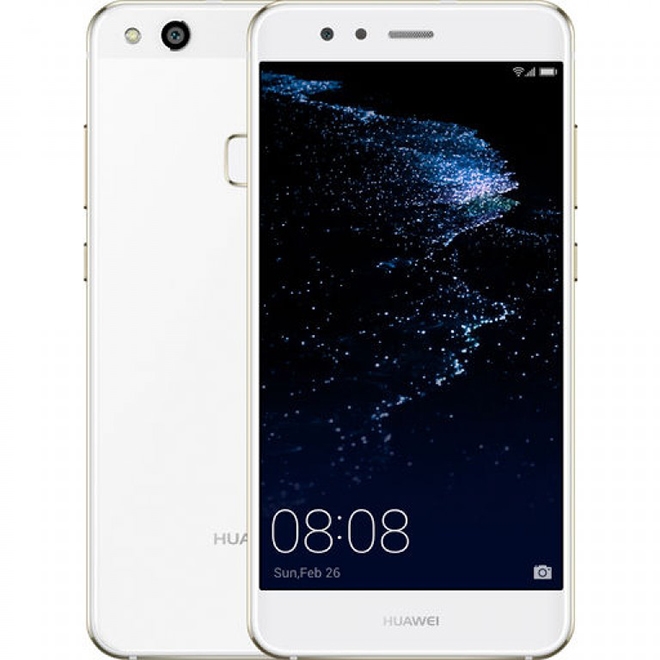
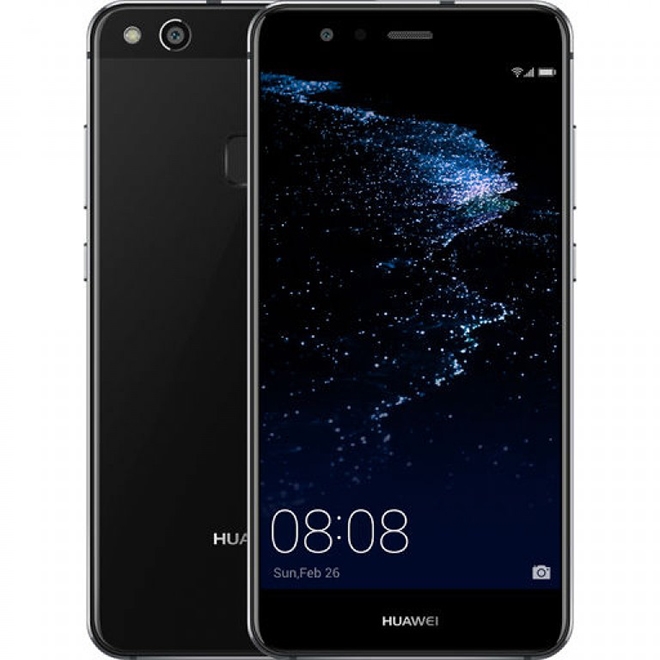

Most of the front panel of Huawei P10 Lite is occupied by a 5.2-inch IPS display with Full HD resolution. For comparison, the flagship device has a screen diagonal of 5.1 inches. As already mentioned, the display is protected by curved glass, which should provide a pleasant tactile sensation and more comfortable operation. The size of the bezel around the screen is only 1.21 mm. Moreover, the press release lists the presence of an upgraded mode for eye protection, although it is not known exactly how it will differ from the existing one in Huawei P10 and other models with EMUI 5 and higher. For the first time for a lightweight model, the Knuckle Sense function was introduced, which expands the touch control of a smartphone using a finger joint.
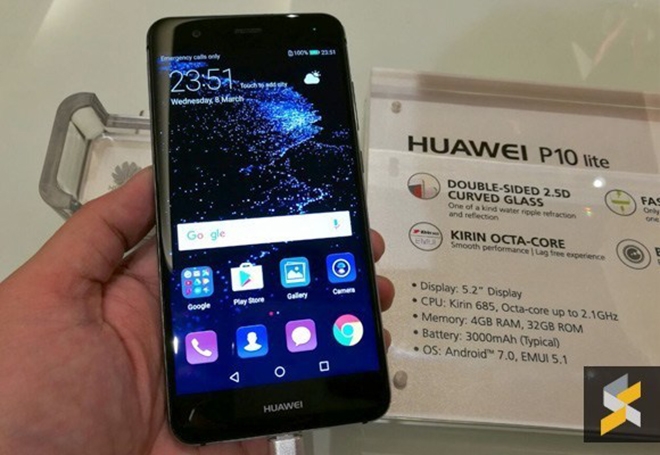
The hardware component of Huawei P10 Lite is based on the new 8-core HiSilicon Kirin 685 processor made using a 16 nm process technology. This chip is an overclocked version of the Kirin 655. It comes with 4 GB of RAM, which when paired with the processor will be enough to play streaming multimedia content, games and other tasks. Data storage is provided by a 32 GB flash drive with the ability to expand with cards MicroSD format, and the device is powered by a non-removable 3,000 mAh battery with support for 9V/2A fast charging and Smart Power-Saving 5.0 energy-saving technology. Within 30 minutes of recharging, 43% of the battery charge is replenished. A full charge is achieved in just over 90 minutes.

The main camera module of Huawei P10 Lite has a single 12 MP sensor with an f/2.2 aperture and a pixel size of 1.25 microns, which allows it to capture more light and details. The selfie camera has a resolution of 8 megapixels and supports many modes, including portrait photography and bokeh effect. Of course, we are not talking about any sensors from Leica.

As with older models, the lightweight version of the flagship runs operating system Android 7.0 Nougat with the latest Emotion UI 5.1 shell installed on top, which better manages system resources to ensure optimal performance at the right time of use. For optimal resource allocation, a special self-learning algorithm was developed to suit the user’s needs.

The Huawei P10 Lite is now available for pre-orders in the UK, priced at £299, and will go on sale on March 31st. In Malaysia, the new product will cost 1,299 ringgit (16,981 rubles).
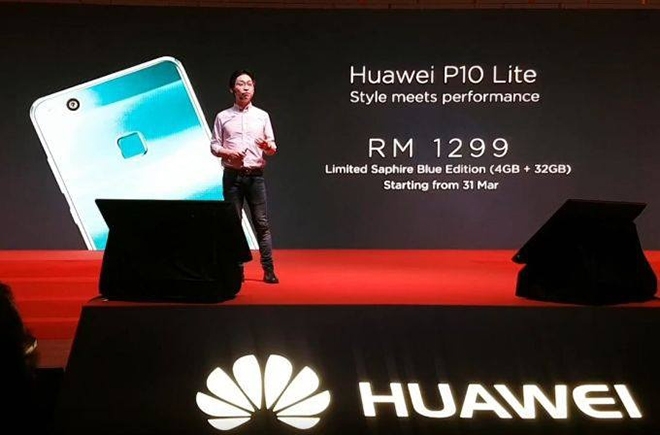
Technical Huawei specifications P10 Lite:
- Operating system: Android 7.0 Nougat, EMUI 5.1
- Screen: 5.2 inches, Full HD
- Processor: 8-core, HiSilicon Kirin 685, frequency 2.1 GHz
- Graphics chip: Mali-T830
- RAM: 4 GB
- ROM: 32 GB, MicroSD
- Camera: 12 MP, f/2.2 aperture, LED flash
- Front camera: 8 MP
- Connectors: MicroUSB, mini-jack 3.5 mm
- Additionally: fingerprint scanner
- Battery: non-removable, 3,000 mAh
According to the already established tradition, along with the new flagship, Huawei also presented its “lightweight” version - P10 Lite. Outwardly it is similar, but in terms of characteristics and materials there are several important differences. According to the manufacturer, it is they who allow us to call this model a junior version the newest flagship, and not just another average guy. Is a smartphone worthy of such a title? Now we'll figure it out.
First impression
At first glance, the Huawei P10 Lite looks like a very familiar smartphone. The manufacturer has not experimented with design for a long time, so many new products are very similar to their predecessors, in this case we are talking about the P9 Lite. By and large, the new product differs from it only in a slightly more rounded body shape and glass rear panel(instead of plastic).
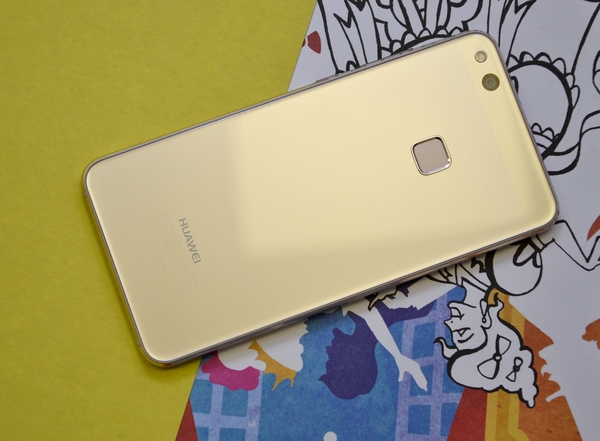
If you look closely, the P10 Lite has a few more differences - a round bezel for the main camera and flash, this time single, and one grille at the bottom instead of the usual two, located on either side of the USB port. The connector, by the way, is not Type-C, although it should be.
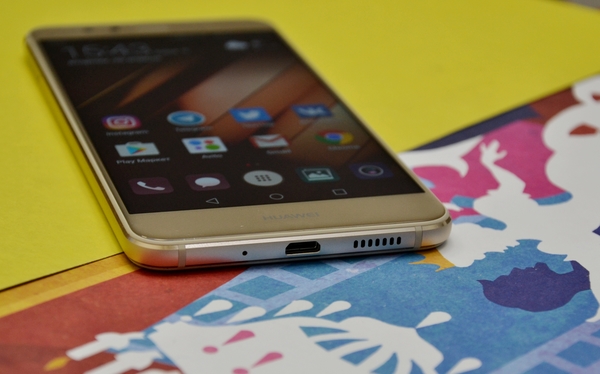
These very careful design changes have benefited the smartphone. It looks more neat and elegant. Due to the greater roundness and pronounced 2.5D effect of the glass on both sides, the design in the golden version looks like “caramel”. Huawei P10 Lite looks especially original in sapphire blue color with a shiny film under the back glass, which shimmers effectively depending on the lighting.
The use of glass on both sides of the case is stylish and modern, but not as practical and aesthetically pleasing as in the case of metal or the same plastic, because two glasses = twice as many fingerprints. The oleophobic coating does not protect against stains and greasy marks, this is especially noticeable from the front. You will have to wipe this “lollipop” often.
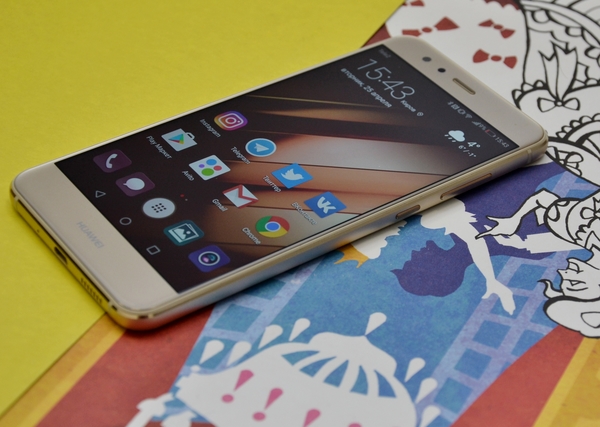
What kind of glass Huawei used is not specified, but it is known that they have Mohs hardness level 7. This means that neither coins, nor keys, nor even a knife will scratch them. In accordance with the same scale, ordinary glass has a hardness level of 6, and iron has a hardness level of 5. It turns out that you can only damage the glass of Huawei P10 Lite with some kind of file or sand - they also have a hardness level of 7. We do not take even harder topazes and diamonds into account.

The weakest point in the design of the P10 Lite is the barely noticeable plastic dividers that act as a connecting link between the glass and the metal frame. They are easy to scratch, so you need to be careful. Otherwise, the gadget is very reliable, you won’t have to take care of it like the apple of your eye and blow off specks of dust once again.
Screen
The smartphone is equipped with a 5.2‑inch screen with a resolution of 1920x1080 pixels. Matrix - LTPS, but there is no trace of its traditional faded colors. The picture, calibrated by default, pleases with color reproduction and viewing angles. In the settings, you can adjust the accent as precisely as possible to your preferences, making it warmer or colder.

In addition, there is an option to increase image clarity in the sun and an eye protection mode, the activation of which can be configured according to a schedule. This will be useful for those who like to read books on their smartphone at night.
Performance
The eight-core HiSilicon Kirin 658 processor installed in the P10 Lite is a good mid-range solution that ensures smooth operation of the interface even with a dozen background tasks. In modern shooters and 3D action games, you can always count on a comfortable game without frame rate drops, but not always with maximum graphics.


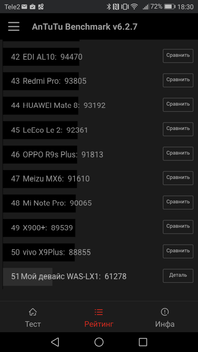
In benchmarks, the results are expectedly good, especially in GeekBench: 905 points in the single-core test and 3,307 in the multi-core test. The same one with Snapdragon 625 scores less: 826 and 2,924, respectively. In AnTuTu, the result of P10 Lite can be called average among “classmates” - 61,278 points. Nova has more than 64,000 points, and , which is also its direct competitor, has over 74,000 points.

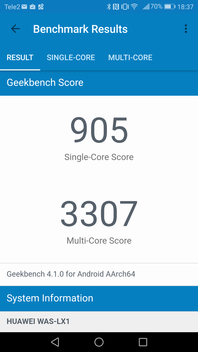

The amount of RAM was 3 GB, which is the norm for the middle class, and the built-in memory was 32 GB. It is possible to expand with microSD cards up to 128 GB ( instead of a second SIM card).
System
The smartphone runs on Android 7.0 Nougat with EMUI 5.1 shell installed on top. With each update, the proprietary interface becomes neater and cleaner, this is good news, but in general there are very few changes in terms of customization and freedom of choice. If you prefer a bare-bones Android design or just like to change interface themes frequently, you won't be happy with EMUI.
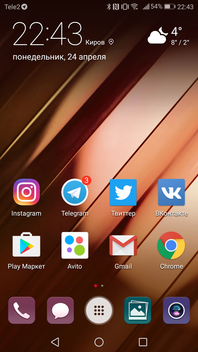
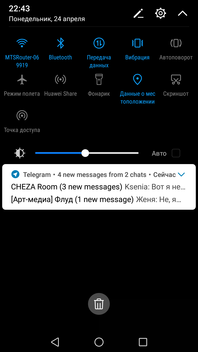

There is a theme store on your smartphone, but you are unlikely to be able to choose something modern and attractive in it. Everything that is high quality and attractive is all in the style of standard themes available by default. Even with the word “Material” you won’t find anything in the theme search; it’s as if the developers deliberately adhere to the design direction chosen by the company.

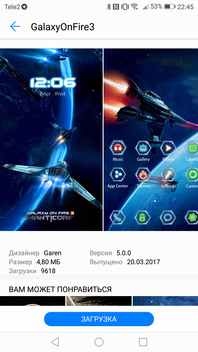
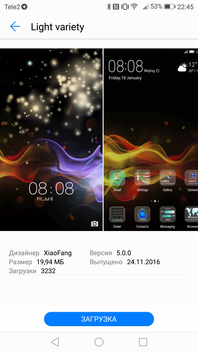
There are no complaints about the speed of operation and smoothness of the interface itself. Almost all standard applications launch very quickly and open quickly from the background.
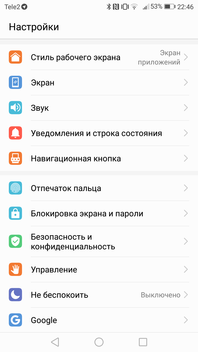

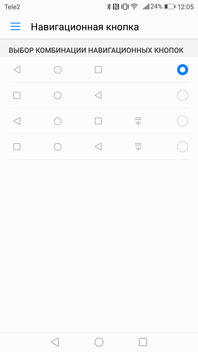
Concerning functionality, then there’s nothing particularly to complain about here either. EMUI 5.1 really has a lot of useful features: there is an icon setting quick launch in the curtain, the so-called long screenshot, the ability to change the desktop scale, the choice of combinations of navigation buttons, a pedometer on the lock screen and the option to launch one application with different accounts (clone application). The latter, for example, allows you to activate two at once Accounts on Facebook or WhatsApp.

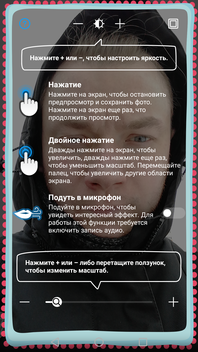

I would especially like to note the appearance of the screen installed applications, which will please those who don’t like it when everything installed games and programs are piled up on desktops. Now they are all in one organized place with search.
Cameras
The main 12-megapixel camera with f/2.2 aperture, 1.25 micron pixels and autofocus allows you to take good macro shots, as well as excellent outdoor photos in sufficient lighting. In such conditions, the camera is able to surprise with its attention to small details and accurate color reproduction without embellishment.
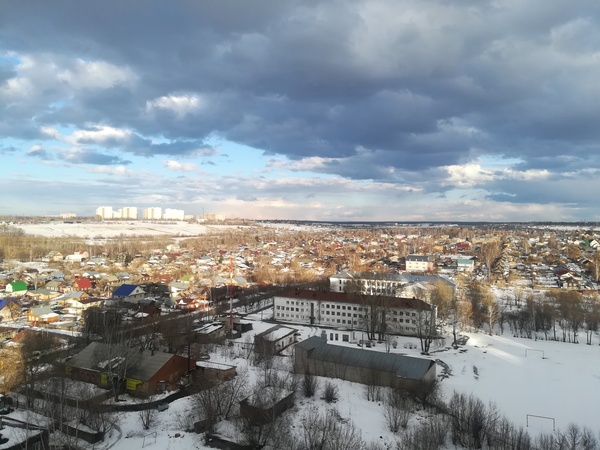







In a room, especially with dim lighting, you will be surprised not by the detail, but by the abundance of noise. This even seemed strange, since a camera with such a sensor, even purely theoretically, should shoot much better in such conditions. Photos are often spoiled by ordinary room lighting.





There is a small problem with light sources at night. If you want to capture some evening lights, you will need to avoid close contact with the same street lights. This will allow you to get high quality photo static objects.


regular selfie on the left, portrait mode with bokeh on the right
The 8-megapixel selfie camera on the P10 Lite is quite good. In simple conditions it shoots well, but by default for some reason it always turns on portrait mode, which tries to “wash” the background. The quality of this bokeh depends on the uniformity of the background and its contrast with the main shot, that is, your face/hair. You can squeeze something interesting out of it, but if you need a sharper photo, you should use the normal mode. You can also blur the background later using other means.
Fingerprint scanner
Rear fingerprint sensor truly flagship. With its help, the screen is unlocked instantly, a speed I have previously seen only in top-end smartphones. Recognition accuracy is almost perfect.

In addition, there are a lot useful options, allowing you to use a scanner to take photos when running application to take pictures, answer calls, turn off alarms, open the notification shade and scroll through images in the gallery. All this works very quickly and accurately - no nerves.
Autonomy
A 3,000 mAh battery provides a day of using the smartphone without fear of sudden discharge when away from a power outlet. In my usage mode there was always a stable 4 hours of active screen. For mid-range devices this can still be called the norm, especially for those with an FHD display.
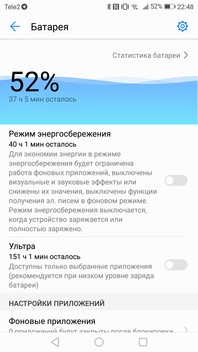
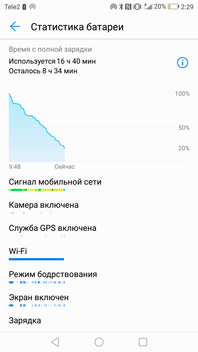
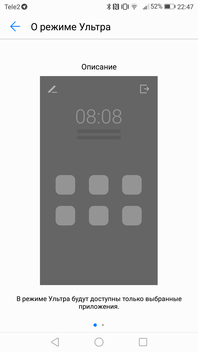
Typically, for emergency situations, when the remaining charge needs to be stretched for a maximum time, manufacturers provide “calls and SMS only” modes. Huawei went further, giving users the opportunity to select some applications that are important to them. This mode is called " Ultra"and it is very convenient and useful away from power outlets. When activated, even the background image and functions such as screenshots are disabled, leaving only access to calls, messages, contacts and three more applications that you choose.
Another nice feature of the Huawei P10 Lite is its proprietary fast charging. SuperCharge, allowing you to replenish 40% of the battery in about half an hour. These are official data that are completely true. A full charge takes about 1 hour 40 minutes, which is not so fast, but still not bad.
Summary
The Huawei P10 Lite really has significant advantages that allow it to be perceived as something more than an ordinary average product. These are exactly the features that it inherited from its “big brother”, the flagship P10. We're talking about a very fast fingerprint scanner, fast charging, a reliable glass body and generally good cameras. Although the main photo module is something contradictory, capable of both delighting and disappointing. Perhaps the existing problems in the shooting algorithms will be corrected with one of the updates. This will allow us to call the P10 Lite almost the best camera phone under 20,000 rubles.
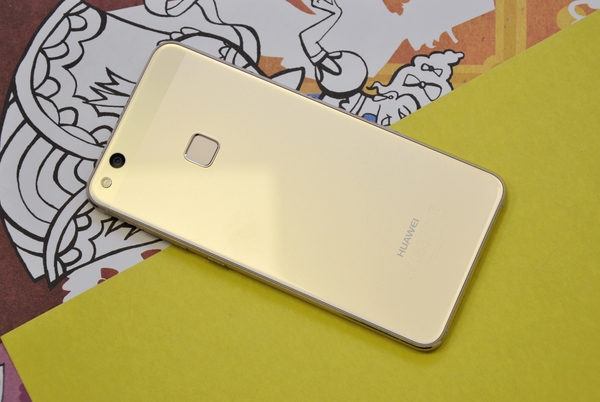
Huawei P10 Lite costs 19,000 rubles and at this price its main competitor, oddly enough, is the Honor 8 lite, which is very similar in appearance. It is a little cheaper, but does not have several important features. We have dedicated a separate comparison of these smartphones. Among other competitors: the slightly more expensive Meizu Pro 6.
Advantages:
- reliable glass case;
- high-quality screen;
- good cameras;
- fast fingerprint scanner;
- accelerated charging.
Flaws:
- staining of glass;
- strong dependence of the main camera on light;
- poor selection of EMUI themes.
Specifications of Huawei P10 Lite:
- OS: Android 7.0 Nougat + EMUI 5.1;
- screen: 5.2‑inch LTPS with a resolution of 1920x1080 pixels and 2.5D glass;
- processor: eight-core HiSilicon Kirin 658 with a frequency of 2.1 GHz and Mali-T830MP2 graphics accelerator;
- RAM: 3 GB;
- memory: 32 GB + microSD up to 128 GB;
- main camera: 12 MP with f/2.2 aperture, 1.25 micron pixels, autofocus, LED flash and 1080p@60fps video recording;
- front-camera: 8 MP with f/2.0 aperture;
- interfaces: Wi‑Fi 802.11 a/b/g/n/ac, Bluetooth 4.1, FM radio, A‑GPS, GLONASS, NFC;
- battery: 3,000 mAh + fast charging SuperCharge;
- USB: microUSB;
- dimensions: 146.5×72×7.2 mm;
- weight: 146 grams.
Review of the very slippery youngest of the elders
26.05.2017
Key Features of Huawei P10 Lite
Now the times have moved on. Light smartphone, yeah. Beautiful, powerful. Yes, half of the manufacturers will have such a smartphone in their flagships! And Huawei has it - so, a gray mouse... A device from the top series, but for those who are poorer and cannot afford a “real flagship”.
Who needs this crazy race between gigabytes and gigahertz anyway? Why all this power in tiny smartphones? Games disappear in the semi-finals, even on medium hardware everything has been fine for a long time. Unless processing information from cameras. If you are making 4K video or super slow-motion shooting at 960 frames per second, you are forced to install hardware that will be able to process all this mountain of information on the go. Something else? Apparently not.
Brief conclusion
First things first. Good news. The P10 Lite is the first Huawei device in recent years on which I had no problems with notifications. Bad news. The P10 Lite is as slippery as a bar of wet soap. God forbid you put it on an insufficiently level surface - it will immediately try to escape. And pray there's something soft underneath.
Otherwise, everything is expected and even boring. What we have before us is simply a very good and solid smartphone.
Price
The official price in the official store is 18,990 rubles. At the same price, plus or minus a few rubles, P10 lite is sold in large stores (DNS, M.Video, Citylink, MegaFon, Svyaznoy, Ozon, Onlinetrade). In small stores the price starts from about 17 thousand.
The official store now gives an additional gift upon purchase external battery 13000 mAh (Huawei AP007) and a protective bumper.
Equipment
Only a telephone carcass came to me for testing. However, it is not difficult to find information on the delivery package. Everything is standard - charger, Micro-USB cable, headphones, paper clip for removing the tray.
Appearance
| Weight | 146 g |
| Size | 146.5 x 72 x 7.2 mm |
| Protection | No |
Four colors - gold, black, white and a very cool blue.
I already mentioned the annoying slipperiness. Not only does it break out of your hands. So even placing it on a table that is too smooth is dangerous. If you push it a little, it leaves. But, perhaps, this is the only complaint about the appearance. I generally don’t like overly glossy things. But I have to admit that the P10 Lite looks cool. Well, at least in black. And it doesn’t even get dirty very actively.
The assembly is excellent. Materials: glass and iron. On-screen buttons. Pleasant to the eye LED. In short, everything is just how I like it.
Some boring details
Above the screen there is an LED, front camera, sensors, speaker.
Below the screen is a shiny logo.
Behind. In the corner there is a camera with a flash. Be careful, it is easy to accidentally cover the camera with your finger. A little lower is the fingerprint sensor recess.
Top edge. 3.5mm audio output and noise canceling microphone.
Bottom. Micro-USB, speaker, main microphone.
On the right are the buttons - the volume rocker and the power button.
On the left is a card tray.
Internals (iron)
| AnTuTu | 59938 (v6.2.7) |
| AnTuTu | 53821 (v5.7.1) |
| Chipset | Huawei Kirin 658 |
| Cores | 4 x Cortex A53 2.36 GHz 4 x Cortex A53 1.70 GHz |
| GPU | Mali T830MP2 |
| RAM | 3 GB |
| ROM (free) | 32 GB (20 GB) |
| Micro-SD | Up to 128 GB |
Eight-core chipset of our own production. The power of the iron is quite expected. Seriously weaker than flagships, seriously stronger than the average quad-core MediaTek. Roughly speaking, if a smartphone on Snapdragon 821 needs two seconds to render a website page, then the P10 Lite will take three seconds. Critical? In my opinion, not too much.
But there is a lot of RAM. However, Huawei would not be itself if it did not strive to clear this very memory, and sometimes with particular cynicism. Those. programs are unloaded from memory very actively, even if there is more than enough free RAM.
Flash memory is a good 32 GB. Alas, the card slot is a hybrid one. Those. if you want to place a card MicroSD memory, you will not be able to use two SIM cards.
Sensors - a standard "large" set. Gyroscope, compass, accelerometer, illumination, proximity.
The fingerprint sensor is located on the back. And, importantly, far from the camera - you won’t miss. Works great.
Communication with the outside world
Everything is neat. There are no problems with communication.
Screen
There are no questions about the screen, it is good. There are better ones, but it's still good. Sufficient brightness (does not fade in the sun). Good minimum brightness. Contrast, resolution - everything is on point. Plus the newfangled 2.5D rounding.
Oleophobic coating There is. And it’s good.
Reviews say that Gorilla Glass is used. I did not find confirmation of this either on the Huawei website or on the Corning website. There is information about P10 and P10 Plus there. And not a word about P10 Lite. Obviously, the glass is good and protected. But there are some doubts about what Gorilla is here.
The only thing is that the screen does not react at all to touches with normal thick gloves. They shouldn't...
Operating system and other software
EMUI 5.1 plus Android 7.0 Nougat. No surprises.
Battery
The battery capacity is average, 3000 mAh. The battery test results were not too impressive - 127% of the standard. A typical "one-day" smartphone, which with average use needs to be charged every night.
